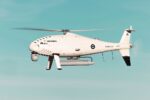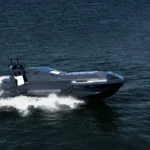In a high-stakes counter-narcotics operation over the Caribbean Sea, Royal Marines deployed aboard a Wildcat HMA2 helicopter successfully disabled a high-speed drug smuggling skiff using precision sniper fire. The mission underscores the evolving role of airborne platforms in maritime interdiction and highlights the integration of intelligence, surveillance and reconnaissance (ISR) with precision engagement from rotary-wing assets.
Wildcat HMA2: A Multi-Role Maritime Interdiction Platform
The Leonardo AW159 Wildcat HMA2 is the Royal Navy’s primary shipborne helicopter for reconnaissance and anti-surface warfare. Operated by 847 Naval Air Squadron (NAS), it is typically embarked on Royal Fleet Auxiliary (RFA) vessels such as RFA Argus or Wave Knight during regional security deployments. In this case, the aircraft was operating as part of Operation CARIBBE—an ongoing UK-US-Canada partnership targeting narcotics trafficking routes in the Caribbean and eastern Pacific.
The Wildcat is equipped with advanced ISR sensors including the Wescam MX-15 electro-optical/infrared (EO/IR) turret and Leonardo Seaspray 7400E active electronically scanned array (AESA) radar. These systems enable long-range detection and tracking of fast-moving surface targets such as go-fast boats used by narco-traffickers. The aircraft can be armed with Lightweight Multirole Missiles (LMM) Martlet or Sting Ray torpedoes for surface or sub-surface threats.
Sniper Engagement from Rotary-Wing Platform
While helicopters are often used for aerial surveillance or insertion of boarding teams during maritime interdictions, direct kinetic engagement via sniper fire remains rare—and technically demanding. In this operation, a Royal Marine sniper aboard the Wildcat engaged the outboard engine of a suspicious skiff using a semi-automatic sniper rifle while flying at low altitude.
The tactic aims to disable propulsion without endangering occupants unnecessarily—allowing follow-on forces to board and seize contraband. According to footage released by UK MoD on May 28th, 2024, multiple accurate shots were fired into the engine block while maneuvering at speed over open water. This required precise coordination between pilot and marksman under dynamic conditions.
Such engagements rely not only on marksmanship but also on stabilized optics and flight control systems that minimize vibration and yaw during firing windows. The MX-15 EO/IR turret likely provided real-time visual tracking support to both pilot and shooter.
Operational Context: Operation CARIBBE & Joint Task Force
This interdiction was part of Operation CARIBBE—a long-running multinational effort involving UK forces embedded within US Joint Interagency Task Force South (JIATF-S). The task force coordinates maritime patrols across known narco-trafficking corridors using assets from multiple NATO partners.
The specific incident occurred in early May 2024 but was declassified later that month following successful seizure operations. After disabling the vessel’s engine via aerial sniper fire, US Coast Guard personnel intercepted and boarded the craft—recovering an estimated £23 million worth of cocaine (~260 kg). Three suspects were detained for prosecution under international maritime law.
This marks one of several successful seizures involving UK rotary-wing assets in recent years. RFA vessels equipped with embarked Wildcats have contributed to multiple multi-ton cocaine seizures since 2021 under bilateral agreements with US Southern Command (USSOUTHCOM).
Tactical Advantages of Aerial Precision Engagement
Aerial sniper engagement offers several advantages over traditional intercept methods:
- Speed: Fast-moving skiffs can outrun many patrol boats; helicopters provide rapid response across wide areas.
- Precision: Disabling engines avoids lethal force while preserving evidence for prosecution.
- Reach: Rotary-wing platforms extend coverage beyond line-of-sight from surface vessels or coastal radars.
- Deterrence: Publicized interdictions may deter future trafficking attempts along observed corridors.
This tactic complements other airborne capabilities such as deploying fast-rope boarding teams or cueing fixed-wing ISR aircraft like P-8 Poseidon or MQ-9 Reaper drones operating under JIATF-S coordination.
Evolving Role of Rotary-Wing Assets in Maritime Security
The use of precision kinetic effects from helicopters reflects broader trends in naval aviation doctrine—where multi-role platforms are expected to deliver both ISR and limited strike effects autonomously. While fixed-wing assets offer greater range or payloads, helicopters like the Wildcat provide persistent presence near task groups or chokepoints such as Panama Canal approaches or Windward Passage.
The integration of snipers into embarked aviation units also reflects lessons learned from counter-piracy operations off Somalia circa 2008–2013—where similar tactics were developed against pirate skiffs approaching merchant shipping lanes. Today’s threats differ in scale but require comparable flexibility across rules-of-engagement thresholds—from surveillance to warning shots to disabling fire if necessary.
Looking Ahead: Modular Payloads & AI Integration
The success of this operation may accelerate interest in modular weaponization options for rotary platforms beyond traditional missiles or torpedoes. Directed energy weapons remain experimental at sea—but AI-enhanced targeting aids for snipers could become viable within this decade.
Leonardo has already demonstrated AI-assisted threat recognition via its Osprey radar family; similar capabilities could be adapted to cue shooters toward vulnerable points on small craft under stress conditions. Additionally, lightweight loitering munitions may one day be launched from Wildcats for longer-range non-lethal interdiction missions where sniping is impractical due to distance or sea state.
Conclusion
This successful interdiction highlights how legacy skillsets—such as marksmanship—are being fused with modern ISR tools aboard agile airframes like the AW159 Wildcat. As maritime security challenges evolve across dispersed theaters like Latin America or West Africa, expect more hybrid tactics that blend surveillance precision with surgical force projection from air-capable platforms embedded within multinational task forces.










